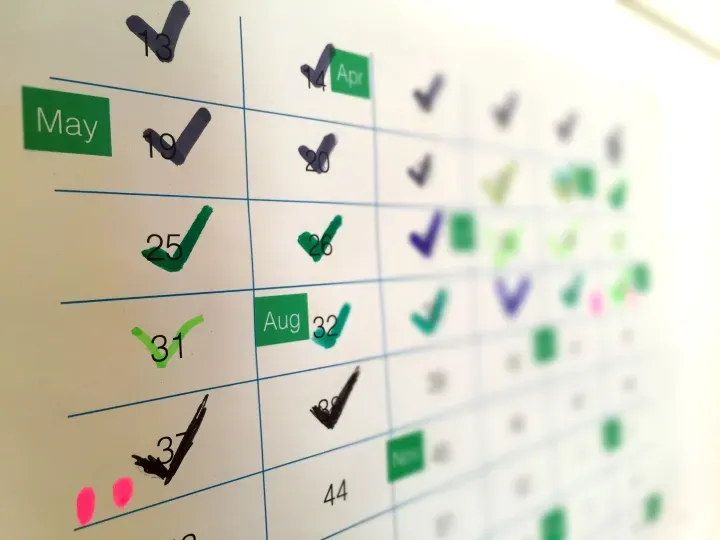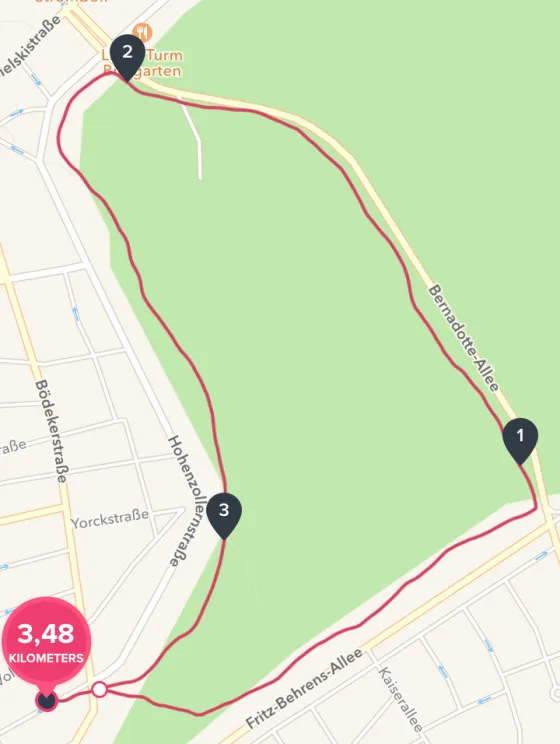New Habits: Nine Tactics That Worked For Me

Studies have shown that about 30% to 50% of what we do in a day can be called habitual [1]. However, adopting new habits is hard: at least I have always struggled with making things stick. But now I think I’ve found something that works for me.
It’s Tuesday. I just had lunch and now take ten minutes to work on this blog post.
Only ten minutes? I surely cannot have written this whole post in just ten minutes.
I haven’t. But I’ve been doing this every day for a few months.
As a result, I usually publish one blog post every month. That might not sound impressive, but it feels like a great achievement to me.
Because, you see —
Good Resolutions
Going back to February 2015: I’ve just published a blog post on a gamification study I did as part of my PhD research. It’s a somewhat polarizing topic, and so the likes, retweets, mentions, and comments keep coming in.
Researchers want to be read because they want their research to have an impact. So this feels great.
I make a mental note: you need to blog at least once a month. You need to create things in public, share things you learn with others. That’s a great way to be valuable to others. It’s also a great investment in yourself.
A year goes by.
I haven’t blogged again.
In the meantime, I started working for Automattic — makers of WordPress.com and many other great tools. Pretty much all of those touch blogging in some way.

How can I work on a blogging platform when I don’t blog myself — even though I had promised myself to do it regularly? Isn’t that hypocritical? And what’s with eating your own dog food?
Something had to change.
I joined the company in December, nicely coinciding with New Year. What better time to make resolutions?
But I didn’t yet believe in the power of habit. I hadn’t felt it yet.
It All Started With Running
As with blogging, I’ve also tried to go running regularly — many times.
- I tried it when I was studying, to get a relief from stress.
- I tried it when I became a father and felt that I needed to invest in my health so I can be a dad for longer.
- And I tried it when we moved to Victoria in Canada, which seemed like an excellent opportunity to turn my (running) life around. There even was lots of social pressure, as per my perception around 90% of Victoria’s inhabitants are runners.
I was never able to make it stick though.
I’d start running and get through it. It would hurt. But I would press on. I’d run longer. I’d run more often.
And then … it fizzled out. I stopped.
I took on too much too fast, ignoring my own level of comfort. It takes time before you see results from running, and increasing your ambitions before you reach those results sets you up for failure. You give up, you procrastinate on it, you forget.
Well, maybe not you. I did, though.
In March this year, I got my company-provided Fitbit. Thank you, Automattic! 🙂
Maybe it was because I had learned more about myself. Maybe it was because of all the research on motivation that I had read and written about as part of my research. Something was different this time.
I set up a recurring task for me in my reminders app. It told me to go running exactly once every week. For twenty minutes.
I glued a paper calendar to the fridge. A single sheet of paper with 52 boxes, each one representing a week. Every time that I returned from running, I’d check off the current week.

And I wore the Fitbit. It has GPS and takes heart rate measurements. So every time I returned from running, I looked at the map and the heart rate graph.

I’ve been doing this for 26 weeks now. Half a year.
At week 12, I started to feel results. I wasn’t out of breath anymore. I wasn’t completely exhausted anymore. I didn’t have to put in a few minutes of walking between bursts of running. I just ran, showered, and was done.
This is my heart rate. The graph on the left is from one of my first runs. The one on the right is from week 13. The route and distance were the same.

A few weeks later, the techniques that helped me become a regular runner also got me started on publishing a blog post every month.
Acquiring New Habits: A How-To Guide
So how did I do it?
I’ll share some tips that helped me acquire these new habits. They may or may not help you — to me it seems like they helped me, but maybe that’s just correlation.
Some of the following things work better when you’re creating something — blogging, writing fiction, or drawing. Others will work better for activities where you don’t directly work on a specific artifact, but rather invest for the long-term benefits like better health through running or becoming better at the piano through daily practice.
1. Triggers and Nudges
The first thing to do for your new habit is to create a trigger.

For me, that’s usually a recurring task with a reminder on my phone. I use Todoist now, and for a long time used Apple’s Reminders app. It doesn’t matter much what you use, but a few things are important:
- You get a reminder, and it doesn’t go away by itself. You have to ackowledge it, and even then it stays there in the background — e.g. in the red badge on the app on your phone.
- You can set it and forget it. You can create daily, weekly, monthly, quarterly, or yearly reminders. You trust the app / system / mechanism to actually remind you.
- Trick yourself into not being able to miss it. If you use an app on your phone, change things around so the reminders are there where you look first. Magic happened when I moved the Kindle app to where I’d had the Twitter app for years. If you use something that’s browser-based, you could make your reminders the start page of your browser.
This will at least make sure that you won’t be able to simply forget about it.
2. Aim Low
Now that you’re reminding yourself to do something regularly, you need to actually do it.
But it’s easy to shove a reminder into the back of your head. The time’s not right. You don’t have enough downtime to do that right now. You need inspiration. A different environment. Maybe you’ll do it tomorrow. Or the day after.
Until you know it, you’re drowning in notifications you’re not acting on. There are so many, the only reasonable way out is to ignore them.
I’ve been there.
For me, the key was to aim really, really low.

For running, I tried to think of the smallest amount I could do — and for me, that was “20 minutes, once a week”. If I’d procrastinate on it, I’d know it immediately: there’s no way I can’t find 20 minutes in a week to take care of my health.
What about blogging? Writing a whole blog post in a single session can be hard, but 10 minutes? You should be able to find those in your hectic day. And if you put in 10 minutes every day, at some point there’ll be a finished blog post. Like this one.
That made all the difference.
For me, there are a few reasons why aiming really, really low works so well:
- Low effort forces you to actually try. If it’s more effort to figure out an excuse, you tend to just do the thing real quick.
- It helps you make your habit normal. After a few weeks, it’s weird when you’re not doing it. Getting reminders or remembering to do it doesn’t throw you off anymore — it’s what you do. You write every day, no big deal. I think it’s important to first focus on building a habit, as opposed getting the actual thing right.
- Even a small amount of writing per day can, over time, grow into something large. A novel is about 50,000+ words. At 260 workdays per year, you’d need to write 193 words every day to write a novel in a year. That doesn’t seem too outlandish.
Make it normal that you do it. That also means to not make it too hard.
You will be tempted to do a bit more, though. However, I’ve found that hurts more than it helps. Especially with running it’s easy to overextend yourself, making your running an experience that you loathe. For me, the key was to consciously force myself to run only 20-30 minutes, and to run more slowly than felt natural.
On the other hand, there will be times when you won’t feel inspired to write. That shouldn’t concern yourself too much, though: inspiration favors those who show up every day. In the worst case you’ll spend 5 minutes searching for a nice image to use for your blog post and call it a day. In other words: allow yourself to do menial or routine things from time to time, even when the goal is to be creative. Just make sure you show up.
Aim low regarding both time and quality.
That doesn’t apply only to your daily or weekly sessions. You also need to aim low globally. This is especially important with things that have a clear end goal that is far in the future — such as writing a novel.
If you attempt to write a piece of fiction on such a new habit, it’s easy to forget that getting through a single novel is also an achievement. You should experience it as often as possible to become better at it and to make that a habit as well.
To do that, you’ll have to resist the temptation of trying to make your first story perfect. Just get through it once. And then once more. And again. Over time, you’ll learn more about the process and become better at it. You won’t ever finish a single one if you try to make that first one perfect.
Remember: you can always rewrite, even after you’ve finished.
Note that I’ve never ever completed a novel, so my data on this one is pretty one-sided so far.
3. Accept Failure
Even then, there will be times where you miss your goal.
Some days I’m so tired that I fall asleep when bringing the kids to bed. Other times too many unplanned things pop up.

In the past, I beat myself up and considered the new habit a failure.
Don’t do that. It’s normal and OK. Try again next time.
One thing I’ve seen people recommend can be summarized as “don’t break the chain,” and my fridge calendar for running is basically that. It contributes to me wanting to go running because I don’t want to break the chain of crossed out weeks.
But that can also backfire. What happens when you break the chain? I once used a website for daily writing, and I’d get awarded badges for increasing the number of consecutive days I’d written. GitHub also used to display a “streak,” the number of consecutive days that you contributed code. Both the writing website and the GitHub streak go back to zero when you miss a single day.
When that happens, it can be hard to pick the habit up again because the reset is just so demotivating. Building up that long streak again seems out of reach or meaningless now.
Aim for consistency, but don’t drag yourself down.
4. Tangible Artifacts
One problem with many “good” habits is that they don’t have any immediate payoff. Many are investments in your future.
Running? I want to be more healthy and live longer, but that’s not going to happen overnight. Results aren’t guaranteed and even if you follow your habit closely, you could still get hit by a bus any day.
Writing? I’d like to write a novel, but doing so at 250 usable words per day would still make it take at least 200 days. And that’s before editing. And editing again. And polishing. Before you know it, this seems like it will take forever.
That’s not very motivating for humans. At least not for this one.
I get motivated when I create something.

So ideally I create something every time I work on my habit. Therefore, I think about what proxy artifacts I could create.
For running, the Fitbit is already a great start. After a run, it gives me a map and neat statistics to look at. I can see my heart rate and pace. And I can compare those things to my previous runs. Medium-term I’ll even be able to see small improvements, like with my heart rate above.
Add to that the weekly calendar on my fridge. It’s just a piece of paper and has no aesthetic value, but to me it’s meaningful. It’s proof that I’m serious about working on something that isn’t comfortable, something I’ve failed at a few times before. The beauty of this artifact to me is that it embodies a break-through in my attempts to modify my own behavior.
For blogging, I create checklists for the subsections I still need to write. Every time I finish one, I check something off. And I feel that I’m making progress.
Feeling progress, even if it’s small, is one of the most powerful motivators. On that note, The Progress Principle [commission earned] is a must-read if you care about your work habits.
What about writing a novel? It’s very similar to blogging. I create small milestones that leave me with finished artifacts. One page that summarizes the story. A longer outline. An overview of the characters and their goals. A scene list in a spreadsheet. I (very) loosely follow the Snowflake Method[commission earned], which already defines a few of those intermediate artifacts.
Remember: most habits make the most sense when you’re thinking long-term. But your monkey brain craves short term rewards.
Feed it. Trick it.
5. A Deadline and a Finishing Condition
But even if you manage to regularly do the thing you’ve set out to do, you’ll only be able to keep at it if you produce actual results at some point. If there are no results, no achievement, no actual progress — what’s the point in the habit, anyway?
For many habits, you’ll need a deadline and a finishing condition.
You need urgency and destination. You need to define for yourself: “What does it mean to be done?”

I write on blog posts because I want to publish those posts at some point.
This one was pretty obvious to me — I had written blog posts before, but now I wanted to publish blog posts regularly. I chose a frequency of once a month.
So the deadline is “by the end of the month.” The finishing condition is “the post is live on my blog.”
I write fiction because I want to tell stories.
Fiction was harder to wrap my head around, and it took me a few months to understand that in this case, I had to explicitly declare a finishing condition and a deadline.
Before I did that — up until very recently, in fact — I was just writing more and more, every day. That sounds nice in theory, but in reality this made me add ideas to my story until things would slip out of my control.
I had no constraints that would let me evaluate ideas and possibly reject them.
But to finish any creative effort, I believe constraints are essential. They force us to give shape to the thing we’re building, to be opinionated.
Now the deadline for finishing my current story is my son’s birthday. And my finishing condition is reading it to him.
I might not make the deadline, but it gives me constraints to shape the story, and something to aspire to. It forces me to be selective and strategic in my writing. It makes me prefer getting it done over getting it absolutely right.
And that, regardless of the outcome, is a good thing: it gives me practice in finishing a story. The next rewrite or the next story will be better.
6. Save Your Momentum
Hemingway has said it before, and I’ll say it again:
Stop when it’s going great.
This is especially true in activities where you create something new, like writing or programming.
Stop while you still know what you have to do next. Then write a note to your future self. The next time you sit down to write, you’ll know what to do and get an instant boost in momentum.
7. Have an Idea Dump
Many of the ideas so far focused on you being reminded of or being able to keep the discipline to actually do the habit. When it comes to something like running, we’re done: you just run. You don’t have to think about that too much.
But what about writing — or any creative endeavor, really? You need material to work with. Ideas. Inspiration.
But when I sit down to write, inspiration doesn’t just strike. Sometimes it does, sure. But i’d rather not rely on it.
Stopping when it’s going well helps here. But it’s also why I keep an idea dump for blog posts and stories I want to write.

When I finish writing something — or just get tired of it and need a change for a bit — I look at my idea dump, scan everything, and decide for something new to work on.
I also use it to jot down ideas for things I’m already working on. When my unconscious decides that my story totally needs this one unexpected twist, I can write it down and come back to it later. So even though I’m only working on things a few minutes at a time, my brain’s background processing coupled with this dump helps me be more productive when sitting down to write.
I don’t run out of material, and it also helps me focus: When I’m unable to write an idea down, it keeps lingering in the back of my head. That can be rather distracting.
When I’m in the middle of a run and have a great idea for a new blog post, it’s actually enjoyable to think through the different angles it might take. I’ll write things down only when I’m back from the run.
But when I’m playing with my kids or focusing on a problem at work, I want to be able to just push the idea aside. Quickly jotting it down in a place I know i’ll come back to helps me do that.
It gives me two things: peace of mind, and material for later.
8. Work in Different Modes
Having an idea dump also means that I have at least two different modes when writing: deciding what to write about, and the actual writing.
But there are many more modes. I might need to brainstorm something, explore different avenues on how things could continue. I might need to organize the material I have so far. And then there’s editing, and publishing.
For me, being explicit to myself about the mode I’m working in at any one time has been a great help.
Let’s say my story is one big mess and I can’t really continue writing on it because I can’t see anymore which way is up.
I could write a bit. And then reorganize here and there. Then write a bit more. And become even more confused.
But by saying “today, I’ll just work on reorganizing things” I give myself permission to not actually write and not feel bad about it. At least to me, that has been freeing.
Before, I’d feel guilty when I’d just shuffle text around but not really add any.
By explicitly switching modes, I acknowledge to myself that this thing that feels unproductive is part of the process, worth doing, and valuable.
9. One Thing at a Time
I told you about making running and blogging habits.
But I also practice playing the piano 20 minutes a day. And I write fiction — or what I hope will be fiction at some point — for 10 minutes every day.
When I started habit-forming myself, I didn’t do any of those things. And I didn’t start with all of them. I built them up over time.
I started with a single thing — running. And only when I realized that I might have found a way to finally be successful in making myself adhere to a new habit, I added another one.
The next one, I only added when I was sure the first two ones were stable behaviors.
Trying to get into multiple habits at once sets you up for failure — I’ve learned that from experience. Do yourself a favor: focus on a single thing. Only add new habits when the ones you’re currently working on are reliably part of your routine.
The Benefits of Habit
Now, every single habit you start might have a different benefit to you. But there are a few meta benefits you get when you do something regularly, out of habit.
Lower Barriers: The thing you do becomes normal, almost automatic. You lower any barriers that might exist in your head. It becomes easier and easier to get started, because you learn a lot about getting started, again and again.
Accelerate Learning: When you do something regularly, you accelerate learning from failures. To get better at writing novels, it’s much more effective to write ten reasonably good novels in ten years than to try to write that one perfect novel in the same time.
The book “Art & Fear: Observations on the Perils (and Rewards) of Artmaking”[commission earned] contains a great story about a ceramics class. In it, half the students were told to produce a single perfect pot by the end of the class. The other half would be graded by the number of pots produced. You won’t believe what happened next! 😉
(The highest-quality pots were from the group with the most practice at making pots.)
Doing something small every day also gives your brain time to process, create connections, generate new ideas, and reflect on your approach. If you write 10 minutes every day, your brain has 23 hours and 50 minutes at its disposal every day to come up with new things to write and improve your writing.
This helps you get better, faster. And it keeps your idea dump filled.
Stay in Context: It’s probably unnecessarily hard to write a whole novel in increments of 10 minutes. For some things, you might really, really need a few hours of continuous, focused time. But restricting yourself to 10 minutes isn’t the point.
When you find you have an hour or two in the evening — the kids are in bed, your spouse is busy … — you can just write. You’ll know where you left off because that was only a few hours ago. You’ll know what problems you’ve been thinking through this week. You’ll know what you want to achieve next. You’ll know writing for a bit is easy, after all it’s something you do every day anyway.
You’re staying in-context every day, and you get better at jumping in and out of different ones. That’s powerful.
This Is Hard
Make no mistake: getting into a new habit isn’t easy. It takes resolve and grit; it takes time to see results.
I also think you need to have purpose for every habit, something that makes it meaningful to you.

But figuring out a way to achieve proxy results while you wait for the real results to kick in makes hanging in there much easier.
Even then, you’ll likely fail, one time or the other. I know I did.
But maybe the techniques above make things just a tiny bit easier for some people. I like to think they helped me, even though I don’t have any hard proof.
For further reading on habits and how to get into them, I recommend The Power of Habit by Charles Duhigg [commission earned]. It helps you understand why you behave the way you do, and how to influence it.
In summary:
- Triggers and Nudges: Use a reminder app. Set up recurring reminders. Ideally start with a clean slate. Maybe a reminders app you use only for your habits.
- Aim Low: You want to learn a new habit, so you need to minimize your resistance to start up, and go through the whole process as many times as possible. Build a hundred shitty websites. Write a hundred bad stories. We learn best by finishing often, not by struggling a decade to write that one perfect novel.
- Accept Failure: Your new habit won’t stick immediately. That’s OK! You’ll miss a few days or weeks here and there. Get up again. Keep going. And most importantly, don’t beat yourself up over it.
- Tangible Artifacts: It’s hard to work on something over a longer period of time and not see any results. Making progress — even if it’s small — is the one thing that motivates people the most. Make sure you feel progress. Invent intermediate artifacts, like outlines. Make a kitchen calendar for your running and look at the maps of your runs. You might not be creating the healthy body immediately, but until then you can look at a colorful dashboard.
- A Deadline and a Finishing Condition: Have a goal, and a deadline by which you want to reach your goal. I tried writing without both, and it just became a mess. You need something to work towards to.
- Save Your Momentum: Stop when it’s going great. Starting up again the next day will be so much easier, and it will keep you going. I put little notes into documents I’m working on to remind myself what I was planning to do next.
- Have an Idea Dump: I have too many ideas and I can only work on a single one at a time. I use an idea dump to get things off my chest so I can continue working on my current thing. And it also gives me new material for when I’m done.
- Work in Different Modes: Acknowledge that you have different work modes. You might start with outlining a story very roughly. Then make a scene list. Then do the actual writing. And editing. And cleaning up. And then publishing it. And then … choosing something new. Planning it. It’s easy to feel unproductive when you’re not consciously acknowledging those things as part of your new habit. You’re allowed to feel good and productive about those things. Remind yourself from time to time.
- One Thing at a Time: Work on a single new habit at a time. If you spread yourself too thin, all those triggers will just sit there, and you’ll start ignoring them. Make that one habit your mission.
There are probably many more ways to nudge yourself into new habits. What are yours?
Have you succeeded at creating a new habit before? What made it work for you? Do you have any tricks up your sleeve that you can share?
Or are you just starting out with a new habit? What is it? How are you approaching it? What are you struggling with?
[1]: Wood, Quinn, and Kashy. Habits in everyday life: thought, emotion, and action. Journal of Personality and Social Psychology, 2002.




